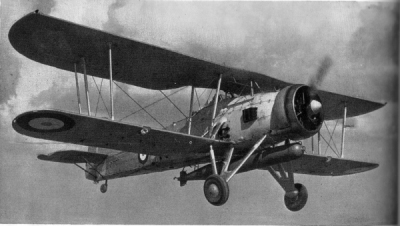![]() The Pacific War Online Encyclopedia
The Pacific War Online Encyclopedia
|
| Previous: Swing, Joseph M. | Table of Contents | Next: Sydney |

Fairey Swordfish Mk.I
| Crew | 2 |
| Dimensions | 45'6" by 35'8" by 12'4" 13.87m by 10.87m by 3.76m |
| Weight | 4700-8700 lbs 2100-3900 kg |
| Maximum speed | 138 mph at 5000 feet 222 km/h at 1500 meters |
| Climb rate | 8 feet per second 2.4 meters per second |
| Service ceiling | 12,400 feet 3800 meters |
| Power plant | 1 690 hp (514 kW) Bristol Pegasus IIIM3 nine-cylinder radial engine driving a three bladed propeller. |
| Armament | 1 0.303
fixed machine gun (nose) 1 0.303 flexible machine gun (rear cockpit) |
| External stores | 1 1610 lb (730 kg) torpedo or 1500 lb (680 kg) mine or equivalent in bombs |
| Range | 546 miles (879 km) with full load |
| Production | 2391 by Fairey-Blackburn from 1935 to 1944-6 989 Mk.I 1080 Mk.II 320 Mk.III |
| Variants |
The
Mk.II had a more powerful engine and rocket
racks under the lower wings. The lower wings were metal skinned to take
the weight of the rockets. |
The Fairey Swordfish, known as "Stringbag" to its crews, was a painfully
obsolete aircraft, typical
of what the Fleet Air Arm had to work with early in the war.
Though very
maneuverable, it was also very slow. It was more successful
than it had any
right to be, but this was mostly because it was employed in the
Atlantic and other distant areas where enemy naval air opposition was
ineffective. Its two
greatest feats were crippling the Bismarck (where
there was no enemy air
opposition at all, and the Bismarck's antiaircraft
fire proved
astonishingly ineffective) and sinking two Italian battleships
at Taranto (where the raid went in at night and achieved a considerable
measure
of surprise.) The Swordfish was almost entirely ineffective
in the Malaya
campaign, where it was present in small numbers, and the British
Far East Fleet was fortunate to never meet a Japanese
carrier task force head on.
The design dated to 1933, with the prototype first
flying on 17 April 1934. The Swordfish entered squadron service in July
1936. It was officially designated as a torpedo-spotter-reconnaissance aircraft, or TSR, intended to locate the enemy fleet, slow it with torpedo strikes, then spot the gunfire
of the British battle line when it caught up with the enemy: "Find,
Fix, and Strike", as the Fleet Air Arm motto expressed it. Production
continued as late as June 1944, in part because of the
failure of its intended successors.
It has been speculated that the reason for the success of the Swordfish against the Bismarck is that the antiaircraft directors on the Bismarck were not designed with so slow an aircraft in mind.
References
The Pacific War Online Encyclopedia © 2007, 2009, 2014 by Kent G. Budge. Index